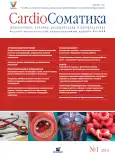Current approaches to diagnosis, treatment and prevention of pulmonary embolism
- Authors: Bershteyn L.L1
-
Affiliations:
- I.I.Metchnikov North western State Medical University, St. Petersburg
- Issue: Vol 5, No 1 (2014)
- Pages: 42-50
- Section: Articles
- URL: https://journals.rcsi.science/2221-7185/article/view/45078
- DOI: https://doi.org/10.26442/CS45078
- ID: 45078
Cite item
Full Text
Abstract
Keywords
Full Text
##article.viewOnOriginalSite##About the authors
L. L Bershteyn
I.I.Metchnikov North western State Medical University, St. Petersburg
Email: L_berstein@yahoo.com
д-р мед. наук, проф. каф. кардиологии им. М.С.Кушаковского
References
- Torbicki A, Perrier A, Konstantinides S et al. Guidelines on the diagnosis and management of acute pulmonary embolism. The Task Force for the diagnosis and management of acute pulmonary embolism of the European Society of Cardiology. Eur Heart J 2008; 29: 2276-315.
- Anderson J, Adams C, Antman E et al. ACC/AHA 2007 Guidelines for the management of patients with unstable angina/non-ST-Elevation myocardial infarction. A Report of the American College of Cardiology/American Heart Association Task Force on Practice Guidelines (Writing Committee to revise the 2002 Guidelines for the management of patients with unstable angina/non-ST-Elevation myocardial infarction). J Am Coll Cardiol 2007; 50 (7): e1-e157.
- Савельев В.С., Чазов Е.И., Гусев Е.И. и др. Ассоциация флебологов России. Всероссийское общество хирургов. Национальное общество по атеротромбозу. Российские клинические рекомендации по диагностике, лечению и профилактике венозных тромбоэмболических осложнений. М.: Планида, 2012.
- Kearon C, Akl E.A, Comerota A.J et al. Antithrombotic therapy and prevention of thrombosis, 9th ed: American College of Chest Physicians evidence - based clinical practice guidelines. Chest 2012; 141: e419S-e494S.
- Бунин Ю.А. Диагностика и лечение тромбоэмболии легочной артерии: современное состояние проблемы. Трудный пациент. 2005; 4.
- Scarvelis D, Wells P.S. Diagnosis and treatment of deep - vein thrombosis. CMAJ 2006; 175 (9): 1087-92.
- Di Nisio M, Squizzato A, Rutjes A.W et al. Diagnostic accuracy of D-dimer test for exclusion of venous thromboembolism: a systematic review. J Thromb Haemost 2007; 5: 296-304.
- Haas F.J, Schutgens R.E, Biesma D.H. An age - adapted approach for the use of D-dimers in the exclusion of deep venous thrombosis. Am J Hematol 2009; 84 (8): 488-91.
- Schouten H.J, Koek H.L, Oudega R et al. Validation of two age dependent D-dimer cut - off values for exclusion of deep vein thrombosis in suspected elderly patients in primary care: retrospective, cross sectional, diagnostic analysis. BMJ 2012; 344: e2985.
- Wood K.E. Major pulmonary embolism. Review of a pathophysiologic approach to the golden hour of hemodynamically significant pulmonary embolism. Chest 2002; 121: 877-905.
- Sanchez O, Trinquart L, Colombet I et al. Prognostic value of right ventricular dysfunction in patients with haemodynamically stable pulmonary embolism: a systematic review. Eur Heart J 2008; 29: 1569-77.
- Mikulewicz M, Lewczuk J. Importance of cardiac biomarkers in risk stratification in acute pulmonary embolism. Cardiol J 2008; 15 (1): 17-20.
- Korff S, Katus H.A, Giannitsis E. Differential diagnosis of elevated troponins. Heart 2006; 92: 987-93.
- Montoya R.C, Gajra A. Current status of new anticoagulants in the management of venous thromboembolism. Adv Hematol 2012; 2012: 856341.
- Steffel J, Braunwald E. Novel oral anticoagulants: focus on stroke prevention and treatment of venous thrombo - embolism. Eur Heart J 2011; 32: 1968-76.
- The EINSTEIN-PE Investigators. Oral rivaroxaban for the treatment of symptomatic pulmonary embolism. N Engl J Med 2012; 366: 1287.
- Рабочая группа Европейского общества кардиологов. Рекомендации Европейского общества кардиологов по диагностике и лечению фибрилляции предсердий. Рацион. фармакотерапия в кардиологии. 2011; (Прил.) 1-2: 3-66.
- Cohen A.T, Tapson V.F, Bergmann J.F et al. ENDORSE Investigators. Venous thromboembolism risk and prophylaxis in the acute hospital care setting (ENDORSE study): a multinational cross - sectional study. Lancet 2008; 371 (9610): 387-94.
- Spyropoulos A.C. Emerging strategies in the prevention of venous thromboembolism in hospitalized medical patients. Chest 2005; 128: 958-69.
- Selby R, Geerts W. Prevention of venous thromboembolism: consensus, controversies, and challenges. Hematology Am Soc Hematol Educ Program 2009; с. 286-92.
- Falck-Ytter Y, Francis C.W, Johanson N.A et al. Antithrombotic therapy and prevention of thrombosis, 9th ed: American College of Chest Physicians. Evidence - based clinical practice guidelines. Prevention of VTE in orthopedic surgery patients. Chest 2012; (Suppl.) 141 (2): e278S-e325S.
Supplementary files







